Features of postinfarction remodeling in able-bodied patients
- Authors: Babushkina G.V.1, Permyakova S.V.2, Gareev D.A.1
-
Affiliations:
- Bashkir State Medical University, Ministry of Health of Russia
- City Clinical Hospital Thirteen
- Issue: Vol 33, No 9 (2022)
- Pages: 39-42
- Section: From Practice
- URL: https://journals.eco-vector.com/0236-3054/article/view/114685
- DOI: https://doi.org/10.29296/25877305-2022-09-07
- ID: 114685
Cite item
Abstract
Objective. To evaluate postinfarction remodeling (PR) according to О myocardial Infarction (О-Mi) location within 1 year in able-bodied men during combination therapy including thrombolysis and maximum doses of statins. Subjects and methods. A follow-up was performed in 106 men under 60 years of age with primary Q-Mi, who were randomized Into 2 groups: 1)55 patients who took rosuvastatin 40 mg/day as part of drug therapy: 2)51 patients received atorvastatln 80 mg/day as part of drug therapy. According to age, the patients were divided Into subgroups: A) 49 (46.23%) young patients aged 30-44 years; B) 57 (53.77%) patients aged 45 to 60years. A control group consisted of 30 apparently healthy people without cardiovascular diseases. Results. The patients with Q-MI who took rosuvastatin for 1 year achieved more pronounced reductions In low-density lipoprotein (LDL) and C-reactive protein (CRP) levels compared to those who received atorvastatln. In the subgroup of young patients, the anterior location of Ml prevailed In 79.6%; In the subgroup of patients aged 45-60years, the lo wer location of Ml was In 64.9%. In both subgroups, the patients with anterior Q-MI showed an Increase In the left ventricle (LV) end-systollc diameter (ESD) during both early and late PR; In those with lower Q-MI, the Increased LV ESD was observed In persons aged 30-44 years during late PR. Conclusion. It is preferable to prescribe rosuvastatin 40 mg/day as part of combination therapy for able-bodied patients with the anterior location of Q-MI, by taking into account the characteristics of PR, as it contributes to a faster achievement of the target level of both LDL and CRP, which is one of the criteria for predicting the severity of Q-MI. One-year administration of the maximum doses of statins has been shown to be safe.
Full Text
About the authors
G. V. Babushkina
Bashkir State Medical University, Ministry of Health of Russia
Author for correspondence.
Email: kapora85@rambler.ru
доктор медицинских наук, профессор
UfaS. V. Permyakova
City Clinical Hospital Thirteen
Email: kapora85@rambler.ru
Ufa
D. A. Gareev
Bashkir State Medical University, Ministry of Health of Russia
Email: kapora85@rambler.ru
Ufa
References
- Жукова А.В , Арабидзе Г.Г., Полякова О.В. Роль комбинированного определения тропониновикопептина в диагностике и прогнозе при остром коронарном синдроме без подъема сегмента ST. Атеросклероз и дислипидемия. 2017; 2 (27): 25-37.
- Насонов E., Попкова Т В. Атеросклероз: перспективы противовоспалительной терапии. Тер арх. 2018; 90 (5): 4-12. doi: 10.26442/terarkh20189054-12
- Диагностика и коррекция нарушений липидного обмена с целью профилактики и лечения атеросклероза. Российские рекомендации, VI пересмотр. Атеросклероз и дислипидемия. 2017; 3:522.
- Жидович Д.М., Щеглова Л.В. Сравнительная оценка показателей постинфарктного ремоделирования левого желудочка в зависимости от тактики лечения острого инфаркта миокарда. Ученые записки СПбГМУ им. акад. И.Л. Павлова. 2013; 20 (3): 75-8. doi: 10.24884/1607-4181 -2013-20-3-75-78
- Хабибулина М.М. Сравнительная характеристика особенностей сердечно-болевого синдрома и безболевой ишемии миокарда у женщин с артериальной гипертензией в период пременопаузы в зависимости от суточного ритма артериального давления. Кардиология и сердечно-сосудистая хирургия. 2011; 4 (3): 55-60.
- Уао Sun. Myocardial repair/remodeling following infarction: roles of local factors. Cardiovasc Res. 2009; 81:482-90. doi: 10.1093/cvr/cvn333
- Дедов Д.В., Иванов А.П., Эльгардт И.А. Влияние электромеханического ремоделирования сердца на развитие фибрилляции предсердий у больных ИБС и артериальной гипертонией. Российский кардиологический журнал. 2011; 4:13-8.
- Albrektsen G., Heuch I., Lochen M.L et al. Lifelong gender gap in risk of incident myocardial infarction. The Trams Study. JAMA Intern Med. 2016; 176 (11): 1673-9. doi: 10.1001/jamainternmed.2016.5451
- Бабушкина Г.В., Пермякова C.B., Губаева A.M. Прогностические маркеры тяжести постинфарктного течения у пациентов трудоспособного возраста, перенесших 0-инфаркта миокарда. Медицинский алфавит. 2020; 21:76-80. doi: 10.33667/2078-5631 -2020-21-76-80
- Han X., Zhang Y., Yin L. et al. Statin in the treatment of patients with myocardial infarction: a meta-analysis. Medicine (Baltimore). 2018; 97 (12): e0167. DOI: 10.1097/ MD.0000000000010167
- Burgos L.M., Battioni L. Costabel J.P. et al. Effect of high-dose statin pretreatment in patients with ST-segment elevation myocardial infarction undergoing primary percutaneous coronary intervention: meta-analysis of randomized controlled trials. Presented on ESC 2019 (P831), 31 Aug 2019.
- Drapkina, O.M. Ivashkin V.T. Improving in arterial stiffness parameters by pulse-wave analysis in obese patients. Atherosclerosis. 2014; 235 (2): e156-e157. DOI: 10.1016/j. atherosclerosis.2014.05.447
Supplementary files








